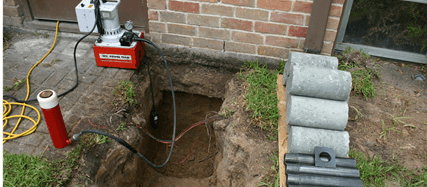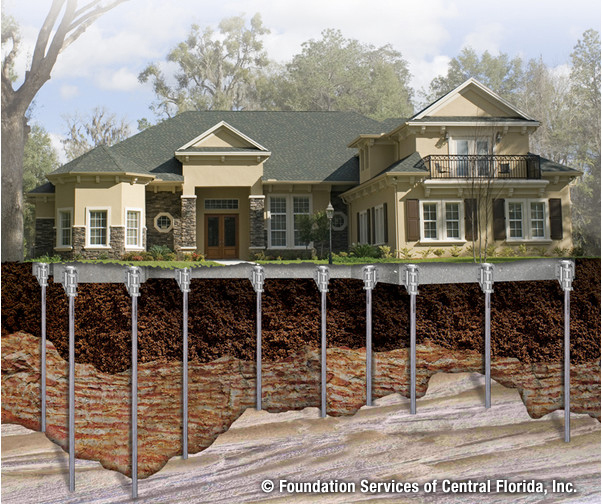Discovering Various Approaches of Foundation Repair Work for Numerous Soil Kinds
Foundation repair work is an important aspect of preserving structural honesty, especially when considering the varied difficulties postured by different soil types. The intricacy of soil habits under varying problems demands a customized strategy to fix, making certain optimal services such as helical piers for unpredictable soils or chemical cements for cohesive layers. The concern continues to be: how do we figure out the most efficient approach for each special circumstance? Recognizing the interplay in between dirt attributes and repair techniques is essential, yet there is more to discover in the quest for lasting options. What variables genuinely determine the option of method?
Understanding Soil Types
Dirt kinds play a vital duty in the stability and long life of structure structures, making it crucial for property owners and construction experts to comprehend their qualities and behavior. The interaction in between soil and foundation can establish the architectural honesty of a building. There are several soil types, each with distinctive physical homes that affect exactly how structures are made and preserved.
Granular soils, such as sand and crushed rock, offer good drain and are usually considered secure. They have high load-bearing capabilities, which can sustain much heavier frameworks. However, these dirts can shift if not compacted correctly, leading to prospective negotiation issues. In contrast, cohesive dirts like clays and silts display different habits. These soils often tend to maintain moisture, and their load-bearing capability can differ considerably with modifications in moisture web content.
Rocky soils, known for their toughness and security, deal superb support for structures yet may require customized devices for excavation. On the other hand, loamy dirts, which are a well balanced combination of clay, silt, and sand, often supply positive problems for foundation assistance as a result of their moderate drain residential or commercial properties.

Understanding these dirt kinds is critical for selecting proper structure repair methods, guaranteeing the toughness and security of structures over time.
Obstacles With Large Clay
Among the numerous soil kinds, large clay offers unique challenges for foundation stability because of its tendency to undertake substantial volume changes with dampness variation. This kind of dirt swells when damp and agreements when dry, which can exert considerable pressure on frameworks. These fluctuations can result in structure splitting, heaving, and settlement concerns, posturing significant dangers to the architectural integrity of buildings.
The obstacles with expansive clay are exacerbated by its plasticity index, which determines the dirt's capability to transform shape and volume. A high plasticity index suggests better possibility for activity, enhancing the possibility of damage to structures. This is particularly bothersome in areas experiencing frequent or severe weather changes, where cycles of damp and completely dry problems prevail.
Moreover, the depth of large clay layers can vary, complicating the evaluation and planning of appropriate foundation repair techniques. The uncertain nature of its motion requires specialized engineering remedies to mitigate dangers. In addition, expansive clay can impact energy driveways, sidewalks, and lines, additionally complicating repair service initiatives. These complexities call for a detailed geotechnical evaluation to guarantee effective structure fixing techniques are carried out, stressing the value of dealing with extensive clay challenges with expertise and care.
Solutions for Sandy Soils
Sandy soils, defined by their big fragment dimension and low cohesion, present unique challenges for foundation stability due to their tendency for changing and disintegration. These buildings necessitate specialized structure repair work techniques to make sure architectural honesty. One efficient solution is the usage of deep structure systems such as helical piers or driven stacks. By securing the foundation to much deeper, more stable soil layers, these systems can supply the needed assistance to combat the moving nature of sandy soils.
An additional suggested strategy is the application of soil stabilization techniques. Chemical grouting, for example, entails injecting a supporting representative right into the dirt, which enhances communication and lowers leaks in the structure. This procedure aids to solidify the sandy substratum, thereby minimizing the risk of erosion and activity.
Furthermore, setting up appropriate drain systems is crucial in sandy dirt conditions. Guaranteeing sufficient drain can stop water accumulation around the foundation, which often exacerbates disintegration and dirt displacement. Methods such as French drains or surface area grading can be employed to direct water far from the structure border.
Dealing With Resolving in Loamy Soils
Fertile dirts, known for their balanced mix of silt, sand, and clay, use an abundant base for lots of frameworks however can sometimes result in structure settling due to their special structure. This balanced texture gives superb drain and nutrient retention, making it ideal for agriculture and landscape design. This exact same attribute can come to be troublesome for structures, as changes in moisture material can trigger the soil to broaden or agreement, leading to resolving.
Dealing with resolving in loamy dirts calls for a complex technique. Exact soil testing is vital to figure out the certain structure and moisture material of the loam. Once information is collected, executing correct drain options is important to preserve consistent moisture levels, thus minimizing the danger of soil tightening or growth. French drains pipes or surface grading are reliable techniques to reroute water far from the structure.

Innovative Repair Service Techniques
In the realm of structure fixing, cutting-edge methods are consistently being developed to resolve the facility tests posed by various soil conditions. As dirt types differ substantially in their architectural residential properties, typical methods might not always are adequate. The advent of new technologies in foundation fixing provides more customized solutions, guaranteeing stability and long life.
One significant technology is the use of useful site helical piers, which are specifically effective in unstable or extensive dirts (foundation repair oklahoma city ok). These piers are screwed right into the ground up until they get to a stable layer of soil, offering strong support for the foundation over. This method lessens disturbance and is adaptable to different soil kinds, making it a flexible option
One more cutting-edge technique is the application of polyurethane foam shot. This technique entails injecting high-density polyurethane foam below the foundation to load voids and maintain the structure. It is a much less intrusive alternative to typical base, supplying quick installment with very little disruption to the surrounding location.
Additionally, soil stablizing techniques, such as the use of chemical grouts, have actually acquired traction. These compounds boost dirt strength and lower leaks in the structure, avoiding future shifting. Jointly, these innovative repair service strategies give efficient remedies for the varied challenges posed by differing soil conditions.
Final Thought

Structure fixing is an important facet of keeping structural integrity, especially More about the author when thinking about the varied challenges posed by different dirt types (foundation repair okc ok). The complexity of dirt actions under differing conditions requires a customized strategy to fix, ensuring optimal remedies such as helical piers for unsteady dirts or chemical grouts for natural layers. By securing the structure to deeper, much more secure dirt layers, these systems can provide the essential support to neutralize the changing nature of sandy dirts
Structure fixing needs mindful factor to consider of soil types to guarantee stability and long life. Chemical grouts enhance soil strength and decrease leaks in the structure in natural soils.